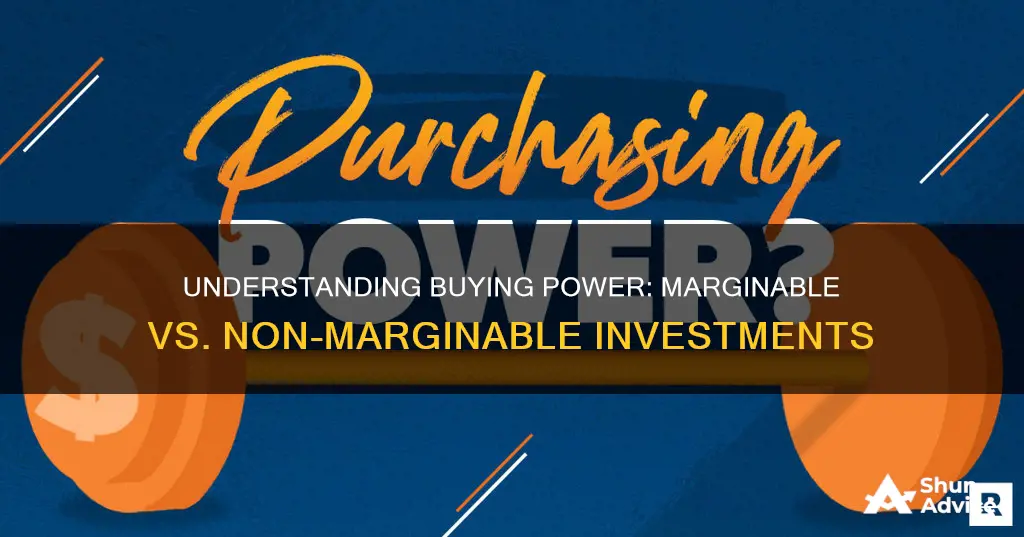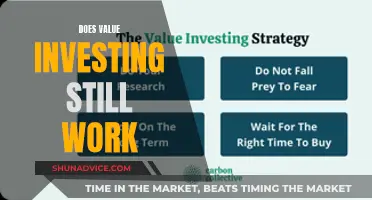
Buying power is the money an investor has available to purchase securities. In the context of non-marginable investments, buying power refers to the funds that an investor can use to buy securities that cannot be purchased using borrowed funds or margin. Non-marginable securities are typically those considered high-risk and illiquid, such as penny stocks or stocks traded over-the-counter. These securities must be fully funded by the investor's cash and usually do not count towards the investor's margin buying power. It's important to note that non-marginable securities are in place to mitigate risks and control costs associated with volatile stocks.
| Characteristics | Values |
|---|---|
| Definition | Non-marginable securities are those that cannot be purchased using margin, usually because these assets are less liquid and higher risk. |
| Examples | Penny stocks, IPO stocks, OTC stocks |
| Who determines which securities are non-marginable? | The Federal Reserve Board has two regulations that govern the use of margin accounts and marginable securities: Regulation T and Regulation U. |
| Who can use margin accounts? | Only some investors qualify to open a margin account and execute margin trades. |
| Buying power | Buying power is the money an investor has available to purchase securities. |
| Buying power of non-margin accounts | For a non-margin account or cash account, the buying power is equal to the amount of cash in the account. |
| Buying power of margin accounts | The amount of margin a brokerage firm can offer a particular customer depends on the firm's risk parameters and the customer. |
| Buying power of day trading accounts | Pattern day trading accounts work differently to regular margin accounts in that they require a minimum equity requirement of $25,000, as opposed to $2,000. |
| Marginable securities | Marginable securities are those that can be posted as collateral in a margin account. |
| Marginable vs non-marginable securities | Marginable securities can amplify returns, but they may also exacerbate losses. |
What You'll Learn
- Marginable securities are those that can be purchased using borrowed funds via a margin account
- Non-marginable securities are those that cannot be purchased using margin
- Margin accounts are similar to buying on credit
- Margin accounts are closely regulated because of the level of risk associated with margin trading
- Margin trading is considered a type of leverage

Marginable securities are those that can be purchased using borrowed funds via a margin account
To open a margin account, investors usually need to meet a minimum deposit requirement, often $2,000, and only some investors qualify due to the associated risks. Margin accounts are regulated by the Federal Reserve Board, specifically Regulation T and Regulation U, as well as by the Financial Industry Regulatory Authority (FINRA) and individual brokerages.
When using a margin account, investors can borrow a portion of the purchase amount of the marginable security, typically up to 50%. For example, with a $10,000 margin account, an investor can purchase up to $20,000 worth of marginable securities. This increased buying power can amplify both gains and losses.
While marginable securities can provide the advantage of increased buying power, they also carry the risk of margin calls. If the value of the margin account falls below the maintenance margin, the investor will receive a margin call, requiring them to deposit additional funds or securities to meet the minimum requirement. Marginable securities can lead to unexpected liquidation of securities and financial loss. Therefore, it is crucial for investors to carefully assess their investment objectives, financial resources, and risk tolerance before engaging in margin trading.
Treasury Bills: Safe and Liquid Investments
You may want to see also

Non-marginable securities are those that cannot be purchased using margin
Most brokerage firms maintain internal lists of non-marginable securities, which investors can usually find online or by contacting their institutions. These lists are adjusted over time to reflect changes in share prices and volatility. It is important to note that holdings in non-marginable securities do not add to the investor's margin buying power.
The main goal of classifying certain securities as non-marginable is to mitigate risk and control the administrative costs associated with excessive margin calls on volatile stocks with uncertain cash flows. By restricting the use of margin for these types of securities, both investors and financial institutions are protected from the potential negative consequences of margin trading.
While margin trading can provide the advantage of increased buying power, it also comes with higher risks. Investors who use margin can lose more money than they have invested if the price moves in the wrong direction. Therefore, it is crucial for investors to carefully consider the risks and ensure they have sufficient cash or marginable securities to cover potential losses.
Dogecoin: Worthy Investment or Just a Meme?
You may want to see also

Margin accounts are similar to buying on credit
When an investor purchases securities with margin funds, they are essentially taking out a loan from the broker. This loan is then used to buy stocks or other investments. The investor does not need to put up the entire value of the trade and can increase their purchasing and trading power.
For example, if an investor has $2,500 in a margin account and wants to buy a stock for $5 per share, they could borrow up to an additional $2,500 from the broker to purchase $5,000 worth of stock, or 1,000 shares. If the stock appreciates to $10 per share, the investor can sell the shares for $10,000. After repaying the broker's loan of $2,500, the trader would make a profit of $5,000. Without the margin loan, they would have only made $2,500.
However, it is important to note that margin accounts also increase the potential for losses. If the stock price declines, the investor will not only lose their own money but also owe interest on the loan to the broker.
Margin accounts are a form of credit that allows investors to leverage their purchasing power. They provide the opportunity for greater profits but also come with higher risks. As such, margin accounts are generally only suitable for sophisticated investors who understand the additional investment risks and requirements associated with margin trading.
Leaving a Lasting Legacy: Directing Your Investments to Charity
You may want to see also

Margin accounts are closely regulated because of the level of risk associated with margin trading
The Financial Industry Regulatory Authority (FINRA) and the Securities and Exchange Commission (SEC) regulate margin trading, with strict rules governing how much an investor must deposit, how much they can borrow, and how much they must keep in their account. By law, a broker is required to obtain the investor's consent to open a margin account. The margin account may be part of the standard account opening agreement or may be a completely separate agreement.
The primary cost of margin trading is the interest an investor has to pay on their loan. Over time, their debt level increases as interest charges accrue. Buying on margin is therefore mainly used for short-term investments. The longer an investment is held, the greater the return needed to break even. If an investment is held on margin for a long period, the odds of making a profit decrease.
Margin trading also exposes investors to the risk of losing more money than they deposited into their margin account. This may occur when the value of the securities held declines, requiring the investor to either provide additional funds or incur a forced sale of the securities.
Margin accounts also carry the risk of a margin call. This is a requirement from the broker to deposit additional funds into the margin account due to a decrease in the equity value of the securities being held. If an investor does not meet the margin call, their brokerage firm can close out any open positions in order to bring the account back to the required level. The brokerage firm can do this without the investor's approval and can choose which positions to liquidate.
Not all stocks, ETFs, or other investment securities qualify to be bought on margin. The Federal Reserve Board regulates which stocks are marginable. Brokers will not typically allow customers to purchase penny stocks or initial public offerings (IPOs) on margin because of the day-to-day risks involved with these types of stocks.
Significant margin calls may also have a domino effect on other investors. If a major investor faces a significant margin call, their forced liquidation may decrease the value of the securities held as collateral by other margin traders, putting these investors at risk of a margin call of their own.
Federal Retirement Funds: Unlocking Investment Strategies
You may want to see also

Margin trading is considered a type of leverage
Margin trading allows investors to borrow funds to purchase more shares than their available capital would normally permit. This financial leverage can significantly magnify profits on successful trades. However, it is important to note that losses can also be amplified, making margin trading a strategy that carries considerable risk.
To engage in margin trading, traders must open a margin broker account, which is distinct from a standard trading account. Traders must deposit a minimum amount of capital, known as the "initial margin", which serves as a good faith requirement. Once the account is funded, traders can borrow up to a certain percentage of the purchase price of the securities, typically expressed as a ratio such as 2:1 (leverage) or 50% margin. This allows traders to double their purchasing power.
For example, with $10,000 in a margin account and a 50% margin requirement (2:1 leverage), a trader could potentially buy up to $20,000 worth of stock. This increased purchasing power is the main advantage of margin trading and can lead to significantly higher returns.
However, it is important to remember that margin trading also increases the potential for losses. If the market moves against a leveraged position, traders may face losses that exceed their initial investment. This can deplete capital rapidly, especially in volatile markets. As a result, margin trading requires careful position sizing and risk management.
Retirement Readiness: Why Prioritizing Your Golden Years Makes Financial Sense
You may want to see also
Frequently asked questions
Buying power is the money an investor has available to purchase securities. It is the total cash held in the brokerage account plus all available margin.
Non-marginable securities are those that cannot be purchased using margin, usually because these assets are less liquid and higher risk. They must be fully funded by the investor's cash.
Margin buying power is the amount of money an investor has available to buy securities in a margin account. It is the total cash held by the investor in a brokerage account plus the maximum margin available to them.







